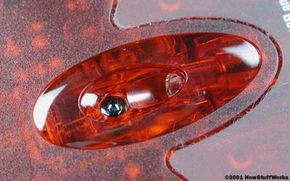Optical Mice
Developed by Agilent Technologies and introduced to the world in late 1999, the optical mouse actually uses a tiny camera to take thousands of pictures every second.
Able to work on almost any surface without a mouse pad, most optical mice use a small, red light-emitting diode (LED) that bounces light off that surface onto a complimentary metal-oxide semiconductor (CMOS) sensor. In addition to LEDs, a recent innovation are laser-based optical mice that detect more surface details compared to LED technology. This results in the ability to use a laser-based optical mouse on even more surfaces than an LED mouse.
Advertisement
Here's how the sensor and other parts of an optical mouse work together:
- The CMOS sensor sends each image to a digital signal processor (DSP) for analysis.
- The DSP detects patterns in the images and examines how the patterns have moved since the previous image.
- Based on the change in patterns over a sequence of images, the DSP determines how far the mouse has moved and sends the corresponding coordinates to the computer.
- The computer moves the cursor on the screen based on the coordinates received from the mouse. This happens hundreds of times each second, making the cursor appear to move very smoothly.
Optical mice have several benefits over track-ball mice:
- No moving parts means less wear and a lower chance of failure.
- There's no way for dirt to get inside the mouse and interfere with the tracking sensors.
- Increased tracking resolution means a smoother response.
- They don't require a special surface, such as a mouse pad.
